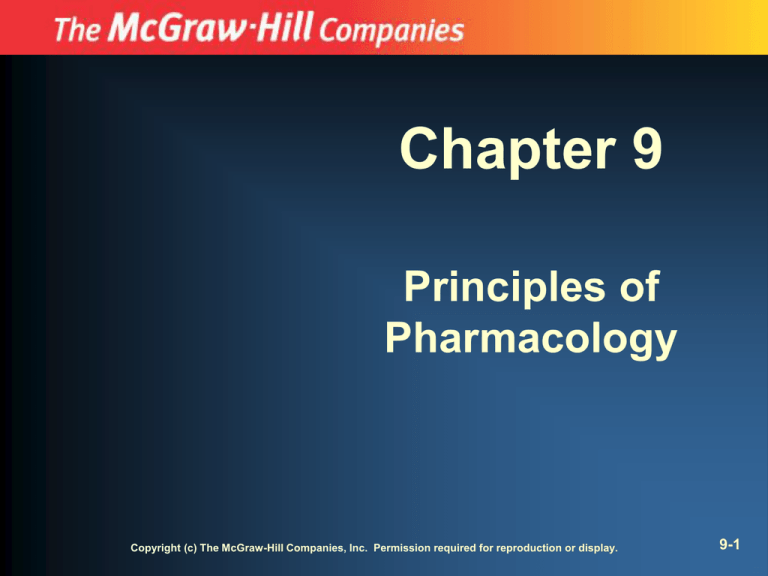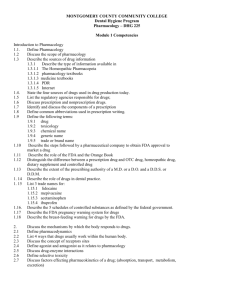Chapter 9 Principles of Pharmacology 9-1
advertisement

Chapter 9 Principles of Pharmacology Copyright (c) The McGraw-Hill Companies, Inc. Permission required for reproduction or display. 9-1 Objectives 9-2 Pharmacology • Pharmacology – The study of drugs or medications and their effect on living systems 9-3 Pharmacology • Pharmacodynamics – The study of the effects of drugs and their mechanisms of action at target sites in the body 9-4 Drug Legislation in the United States 9-5 Drug Legislation • Protects the public from contaminated or mislabeled drugs • 1848 – Drug Importation Act – Required U.S. Customs Service inspectors to stop entry of contaminated drugs from overseas 9-6 Drug Legislation • 1902 – Biologics Control Act – Passed to ensure purity and safety of serums, vaccines, and similar products used to prevent or treat diseases in humans 9-7 Drug Legislation • 1906 – Pure Food and Drug Act • Prohibited interstate commerce in misbranded and impure foods, drinks, and drugs 9-8 Drug Legislation • 1912 • Shirley Amendment • Prohibited labeling medicines with false therapeutic claims intended to defraud the purchaser 9-9 Drug Legislation • 1914 – Harrison Narcotic Act – Established the word “narcotic” – Required prescriptions for products exceeding the allowable limit of narcotics – Required increased recordkeeping for physicians and pharmacists who dispense narcotics 9-10 Drug Legislation • 1937 • Elixir of Sulfanilamide kills 107 persons, many of whom were children 9-11 Drug Legislation • 1938 – Federal Food, Drug, and Cosmetic Act of 1938 – Required that new drugs be shown to be safe before marketing – Established the FDA’s responsibility for supervising and regulating drug safety – Authorized factory inspections – Required that drugs contain a label listing all of the ingredients and directions for use 9-12 Drug Legislation • 1951 – Durham-Humphrey Amendment • Required that prescription drugs (also called legend drugs) must carry the following label: “Caution: Federal law prohibits dispensing without a prescription.” 9-13 Drug Legislation • 1962 – Kefauver-Harris Drug Amendments – Passed to ensure drug effectiveness and greater drug safety – Drug manufacturers required to prove to FDA the effectiveness of their products before marketing them 9-14 Drug Legislation • 1970 – Controlled Substances Act – Established five schedules (classifications) of drugs based on their accepted medical use in the United States, abuse potential, and potential for addiction 9-15 Drug Legislation • 1983 – Orphan Drug Act – Enabled FDA to promote research and marketing of drugs needed for treating rare diseases 9-16 Drug Legislation • 1988 – Food and Drug Administration Act – Officially established FDA as an agency of the Department of Health and Human Services 9-17 Drug Legislation • 1990 – Anabolic Steroid Act – Identified anabolic steroids as a class of drugs and specified over two dozen items as controlled substances 9-18 Federal Regulatory Agencies and Services 9-19 Federal Regulatory Agencies • Drug Enforcement Agency (DEA) – Division of the Justice Department – Became the sole legal drug enforcement agency in July 1973 • Food and Drug Administration (FDA) – Enforces Federal Food, Drug, and Cosmetic Act 9-20 Drug Sources • Plants • Minerals or mineral products • Animals and humans • Synthetic, semi-synthetic drugs 9-21 Drug Names • Chemical name • Generic name • Trade name Generic Name albuterol ibuprofen sildenafil citrate Trade Name Chemical Name Proventil, Ventolin alpha1[(tert-Butylamino)methyl]-4hydroxy-m-xylene-alpha, alpha´-diol sulfate Motrin, Advil, (±)-2-(p-isobutylphenyl) propionic acid Midol Viagra, Revatio 1-[[3-(6,7-dihydro-1-methyl-7-oxo-3propyl-1H-pyrazolo[4,3-d]pyrimidin- 5yl)-4-ethoxyphenyl]sulfonyl]-4methylpiperazine citrate 9-22 Sources of Drug Information • United States Pharmacopeia (USP) • American Hospital Formulary Service (AHFS) • Physician’s Desk Reference (PDR) • Patient package inserts 9-23 Drug Forms 9-24 Drug Effects • Local effects • Systemic effects 9-25 Drug Forms • Gas – Breathed in and absorbed through the respiratory tract – Example • Oxygen 9-26 Drug Forms • Liquid – Contain medication that is ground into a powder and mixed with a substance, such as water – Examples • • • • • Elixir Emulsion Gel Lotion Suspension 9-27 Drug Forms • Solid – A drug that is in solid form is usually swallowed – Requires a responsive patient who is cooperative and has an intact gag reflex 9-28 Drug Profile 9-29 Drug Profile • • • • • • • • Generic and trade names of the drug Mechanism of action Indications Dose Route of administration Contraindications Adverse effects Special considerations 9-30 Questions? 9-31





